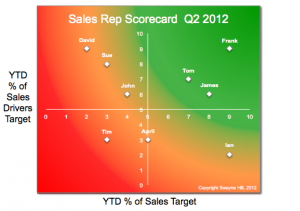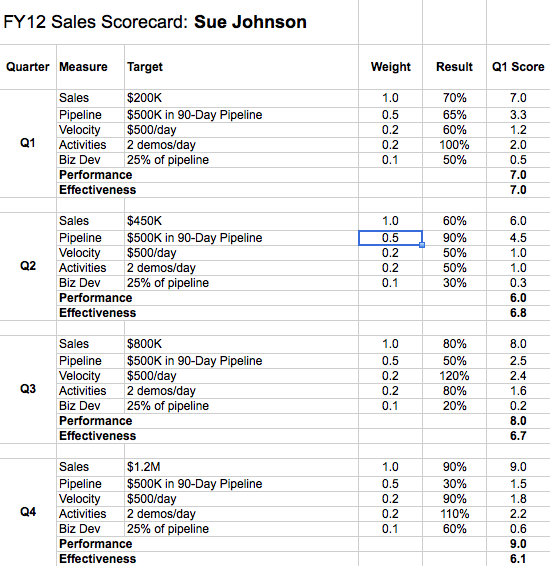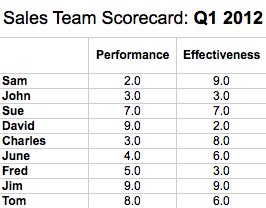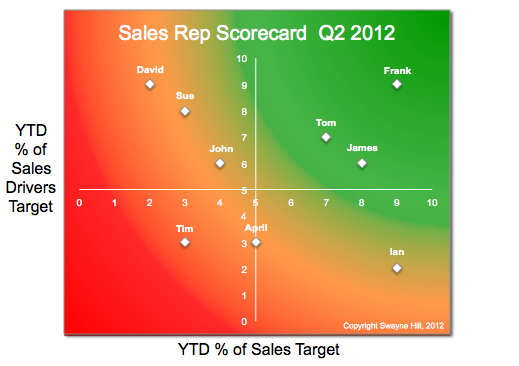How to use sales rep scorecards to drive sales performance
How to use sales rep scorecards to drive sales performance:from Building Scalable Businesses: The Inflexion-Point Blog
I'm very pleased to be able to share another must-read guest article from the ever-insightful Swayne Hill of Data-Driven Sales Management. If you're looking for reliable ways to drive sales performance, sales rep scorecards can help you identify key areas for improvement and stimulate healthy competion between sales team members. Over to you, Swayne...
 "Creating sales rep scorecards will help you improve sales performance by sending clear expectation signals, identifying coaching opportunities and inspiring healthy competition. The single biggest reason you will lose top talent is poor management. Assuming people are compensated competitively and other basic needs are looked after, if they are not clear about what’s expected of them or how their success is connected to the company’s progress, they will probably leave at the worst possible time.
"Creating sales rep scorecards will help you improve sales performance by sending clear expectation signals, identifying coaching opportunities and inspiring healthy competition. The single biggest reason you will lose top talent is poor management. Assuming people are compensated competitively and other basic needs are looked after, if they are not clear about what’s expected of them or how their success is connected to the company’s progress, they will probably leave at the worst possible time.
In the mid-2000′s, Jack Welch wrote about his ‘Rank and Yank’ performance management model where performance is assessed across the ’4-Es’ (Execution, Edge, Energy, Energize) and the bottom 10% are fired. While, this may not be a perfect parallel and others argue that managing by metrics is killing employee engagement, there are important concepts you can borrow to create effective Sales Rep Scorecards.
Here's how to do it...
1. Establish Sales Performance Targets
To keep things simple, stick to two types of targets: performance and effectiveness. Performance targets are nothing more than sales quotas for a specific period and effectiveness targets are tied to activities/behaviors known to drive performance. I like to think of these two dimensions answering the questions, "are you making your number" and, "are you doing the right things?"
In the example below, Sue's Q1 sales quota is $200K and her effectiveness targets are associated to maintaining enough sales pipeline, sales pipeline velocity, activities and business development.

Pipeline: based on an assumed 20%, 90-day win rate from the pipeline, each sales person needs to maintain a constant 5x their monthly quota
Velocity: the sales pipeline velocity calculation pulls together all of the top sales effectiveness drivers - win rates, selling time, deal size and number of active opportunities. In order to hit the full-year sales target, each Sales Rep must maintain an average $500/day in pipeline velocity.
Activities: check your sales opportunity scoring system for leading activity/milestones indicators on future sales, in this example it's simply "meetings" and an average of 2/day are required to stay on target
Biz Dev: sales pipeline is sourced from either marketing or from your sales rep's own efforts. While, you want most of your sales rep’s activity focused on selling, some of their time must be devoted to developing their own territories. In our example above, it's expected that 25% of the pipeline be sourced by the sales rep.
Weighting: the sum of "weighting" numbers for the effectiveness score (Pipeline, Velocity, Activities, Biz Dev) equals 1 in order to normalize the final score for charting and comparisons, each element is weighted relative to it's impact on the over-all "are you doing the right things" measure. Of course, weighting for Sales (the only Performance measure) is 1, for normalization/charting purposes.
2. Summarize Sales Team Performance
Once you've put together the sales rep scorecard - Excel is fine - create a link to a summary page to pull all sales reps together and at this point you only really need the actual scores. You might want to track changes over time, year-to-date, period specific, etc. but I'll keep this simple for illustrative purposes.

3. Publish Sales Rep Scorecard Summary to Encourage Competition
While competition amongst engineers, marketers or product managers may not be helpful, it certainly is for your sales team. The type of person who succeeds in sales is almost always competitive by their very nature, driven to win. Fuel that spirit of competition by publishing team stats and comparing each Sales Rep's score to the others. Pick your favorite BI tool to publish the results; here's an example of what it might look like in Excel. As you can see, I've borrowed a standard 2x2 matrix, often used by Gartner and McKinsey to categorize the sales rep scores.

4. How to Interpret Your Sales Rep Scorecard
Now that you've charted your sales team's performance according to each sales rep's scorecard, interpretation is easy:
Bottom Left - these are the people who are not making their Sales numbers and they are not doing the right things. Their days are numbered, staying in this quadrant for too long is a signal they're not in the right job.
Top Left - these sales reps are doing the right things but not yet producing bookings. They deserve your attention and are great candidates for continued coaching. You should expect to see steady progress to the right; in fact, they're the ones most likely to get to the upper-right quadrant over time.
Bottom Right - these people will bring you down. They are making their numbers in spite of an unwillingness to do the right things. Other people look up to them because they're making money but if you don't address this group decisively, they will undermine your over-all sales program. They need to get out of this quadrant, they're either moving up or the minute they move to the left, they're gone.
Top Right - of course, this is where you want everyone - making their sales numbers and doing all the right things. These sales reps should be publicly rewarded and more highly compensated. These are probably your top performers.
Results - Improve Sales Performance
Creating and managing to targets across a range of sales drivers will set clear expectations about what's needed to achieve success over the long-run. The sales rep Scorecard is a simple addition to your sales management bag of tricks and will help align the team, direct coaching efforts to the right people and inspire healthy competition. These are key ingredients to improving and/or sustaining sales performance."
Swayne Hill | Data-Driven Sales Management
So there you have it - a simple yet incredibly powerful tool for driving the right behaviours across your sales team. I strongly suggest that you subscribe to Swayne's blog - I've always found his ideas highly practical and incredibly insightful.Implementing sales rep scorecards is just one of a number of fundamental building blocks that support the creation of a truly scalable sales and marketing machine. If you haven't already, I'd like to suggest that you invest 10 minutes in completing our on-line B2B sales and marketing self-assessment - I'm sure it will help you identify at least one potential area for improvement.

No comments:
Post a Comment